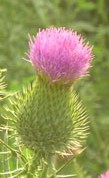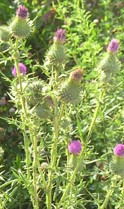 Bull thistle is a biennial weed common in Europe and Asia. It was introduced into North America in the 1800s and has naturalized all over the United States including Hawaii and Alaska. It is usually found in disturbed areas such as roadsides, ditch banks, logged areas and pastures but makes its way into gardens and lawns. It is not a major problem in vegetable gardens or annual beds where tilling the soil each year prevents it from completing its two year life cycle. The flowers provide nectar to many insects including honeybees, wool-carding bees, and butterflies. Birds, especially finches, are attracted by the seeds.
Bull thistle is a biennial weed common in Europe and Asia. It was introduced into North America in the 1800s and has naturalized all over the United States including Hawaii and Alaska. It is usually found in disturbed areas such as roadsides, ditch banks, logged areas and pastures but makes its way into gardens and lawns. It is not a major problem in vegetable gardens or annual beds where tilling the soil each year prevents it from completing its two year life cycle. The flowers provide nectar to many insects including honeybees, wool-carding bees, and butterflies. Birds, especially finches, are attracted by the seeds.

 Description: The first year bull thistle appears as a rosette up to three feet in diameter of oblong leaves bearing spines on their margins. Older leaves may have hairs on the upper surface. The following year the plant sends up a 2-5” tall hairy branched stem bearing spiny “wings” and gray-green lanceolate leaves that are deeply lobed and armed with spines. Coarse hair covers the upper surface and fine whitish hair covers the lower surface. Compact flower-heads l½-2” wide and rose to reddish rose in color appear in mid- to late summer singly or in clusters and are surrounded by spiny-tipped bracts. A single plant can produce up to 10,000 seeds which bear a plume-like appendage that facilitate wind dispersal and can remain viable in the soil for over ten years. A fleshy tap root anchors the plant.
Description: The first year bull thistle appears as a rosette up to three feet in diameter of oblong leaves bearing spines on their margins. Older leaves may have hairs on the upper surface. The following year the plant sends up a 2-5” tall hairy branched stem bearing spiny “wings” and gray-green lanceolate leaves that are deeply lobed and armed with spines. Coarse hair covers the upper surface and fine whitish hair covers the lower surface. Compact flower-heads l½-2” wide and rose to reddish rose in color appear in mid- to late summer singly or in clusters and are surrounded by spiny-tipped bracts. A single plant can produce up to 10,000 seeds which bear a plume-like appendage that facilitate wind dispersal and can remain viable in the soil for over ten years. A fleshy tap root anchors the plant.

 Control: The huge amount of seed produced is the major cause of bull thistle infestations. Cutting the root 1-2” inches below the soil level either in the rosette form or as the 2nd year plants are producing their flowers is the most effective way of removing them from garden or lawn. Plants that are cut too soon or not deeply enough will resprout. Yearly deep cultivation can be an effective control measure too. Herbicides can be used but are not usually needed for small scale elimination of this weed in the garden.
Control: The huge amount of seed produced is the major cause of bull thistle infestations. Cutting the root 1-2” inches below the soil level either in the rosette form or as the 2nd year plants are producing their flowers is the most effective way of removing them from garden or lawn. Plants that are cut too soon or not deeply enough will resprout. Yearly deep cultivation can be an effective control measure too. Herbicides can be used but are not usually needed for small scale elimination of this weed in the garden.